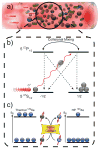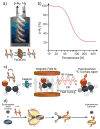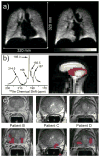NMR hyperpolarization techniques for biomedicine
- PMID: 25470566
- PMCID: PMC4418426
- DOI: 10.1002/chem.201405253
NMR hyperpolarization techniques for biomedicine
Abstract
Recent developments in NMR hyperpolarization have enabled a wide array of new in vivo molecular imaging modalities, ranging from functional imaging of the lungs to metabolic imaging of cancer. This Concept article explores selected advances in methods for the preparation and use of hyperpolarized contrast agents, many of which are already at or near the phase of their clinical validation in patients.
Keywords: dynamic nuclear polarization; hyperpolarization; medicinal chemistry; molecular imaging; spin exchange optical pumping.
© 2015 WILEY-VCH Verlag GmbH & Co. KGaA, Weinheim.
Figures





References
-
- Zeeman P. Nature. 1897;55:347.
-
- Carver TR, Slichter CP. Phys Rev. 1953;92:212–213.
-
- Muradyan I, Butler JP, Dabaghyan M, Hrovat M, Dregely I, Ruset I, Topulos GP, Frederick E, Hatabu H, Hersman WF, Patz S. J Magn Reson Imaging. 2013;37:457–470. - PMC - PubMed
- Nikolaou P, Coffey AM, Walkup LL, Gust BM, Whiting N, Newton H, Barcus S, Muradyan I, Dabaghyan M, Moroz GD, Rosen M, Patz S, Barlow MJ, Chekmenev EY, Goodson BM. Proc Natl Acad Sci U S A. 2013;110:14150–14155. - PMC - PubMed
Publication types
MeSH terms
Substances
Grants and funding
LinkOut - more resources
Full Text Sources
Other Literature Sources
Medical

